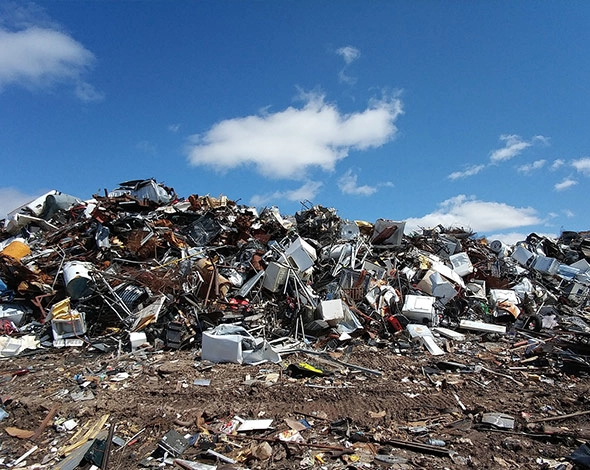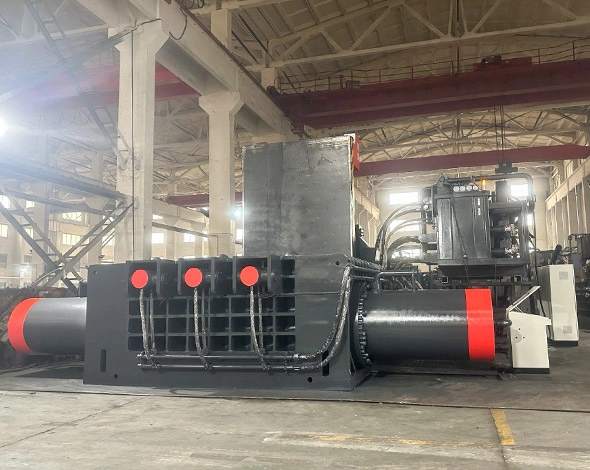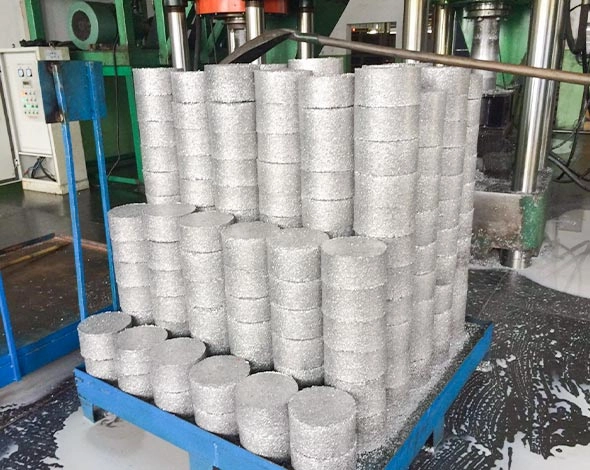The scrap metal recycling industry is facing unprecedented challenges, driven by fluctuating commodity prices, stringent environmental regulations, and rising operational costs. As global demand for recycled materials continues to grow, the industry is under pressure to increase efficiency while maintaining profitability.
ROI is a critical metric for scrap metal recycling companies, where profitability relies on operational efficiency and cost control. Investing in the right equipment boosts productivity, cuts waste and labor costs, and ensures competitiveness and sustainable growth in a challenging market.
The Role of Scrap Metal Recycling Equipment in Reducing Costs
Equipment Overview
Purchasing cutting-edge scrap metal recycling machinery is essential for lowering operating expenses and boosting productivity. Key equipment such as balers, shredders, and sorting systems plays a vital role in streamlining processes, minimizing waste, and reducing the need for manual labor. Below is an overview of these critical tools and their impact on cost reduction:
| Equipment Type | Impact on Costs | Efficiency Improvement | Waste Reduction |
| Metal Balers | Reduces storage and transportation costs by 20% | Compresses scrap by up to 80% | Minimizes space requirements by 30% |
| Shredders | Lowers processing costs by 25% | Processes up to 5 tons of metal per hour | Increases material recovery by 40% |
| Sorting Systems | Reduces contamination-related losses by 10% | Achieves metal purity levels of 99% | Maximizes resale value by 15% |
| Metal Shears | Reduces manual labor costs by 20% | Increases processing speed by 25% | Enhances overall processing efficiency |
| Briquette Presses | Lowers storage costs by 30% | Compacts metal chips into dense briquettes | Reduces metal chip waste by 60% |
| Scrap Grabs | Reduces handling labor costs by 30% | Handles large scrap volumes 50% faster | Improves material handling efficiency by 40% |

As illustrated in the table and chart, each piece of equipment plays a specific role in reducing costs and improving operational efficiency. For example, Metal Balers can compress scrap metal to significantly reduce storage and transportation expenses, while shredders enhance processing speed and material recovery, contributing to lower overall costs.
Long-Term Savings
Investing in advanced recycling equipment not only yields immediate cost reductions but also generates substantial long-term savings. Energy-efficient designs are used in the construction of modern machinery such as shredders and balers, which use less electricity to operate at peak efficiency. According to a report by the Environmental Protection Agency (EPA), companies that upgraded to energy-efficient equipment saw a 20% decrease in energy consumption, leading to annual savings of approximately $50,000 per facility (EPA, 2022).
Additionally, these devices are designed to last, requiring fewer upkeep and repairs over time. By implementing predictive maintenance technologies, businesses have reported a 30% reduction in maintenance costs and a 20% increase in equipment lifespan, further enhancing ROI (Source: McKinsey & Company, 2023).
The financial gains from lower operating expenses are simply the tip of the iceberg. Investing in modern recycling equipment also leads to significant improvements in efficiency and productivity, which further boosts profitability.
Improved Efficiency and Productivity
Operational Efficiency
Advanced recycling equipment significantly enhances operational efficiency by increasing the speed and accuracy of processing scrap metal. High-tech balers, shredders, and sorting systems enable businesses to process larger volumes of material more quickly, directly translating into higher productivity. For example, a state-of-the-art shredder capable of processing up to 5 tons of metal per hour allows companies to manage more scrap with fewer resources.
A case study from a mid-sized recycling facility that invested in a modern shredding system showed a 30% increase in daily material processing capacity. This improvement allowed the facility to expand its operations, secure more contracts, and increase revenue without additional labor costs (Source: Recycling Today, 2023).
Reduced Labor Costs
Automation is a crucial component of modern recycling technology, drastically reducing the need for manual work. Automated systems for baling, sorting, and handling scrap metal can operate with minimal human intervention, leading to significant savings in labor costs. Furthermore, human error might result in material loss or safety issues; automation lowers this risk.
Automation offers particularly clear financial benefits in large-scale enterprises when labor expenses account for a major amount of the total budget. For instance, a company that implemented automated sorting systems was able to reduce its workforce by 15%, resulting in annual savings of over $100,000 in wages and benefits (Source: BLS, 2022).
Increased Profitability through Material Recovery
Maximized Material Value
Efficient sorting and processing equipment are essential for maximizing the value of the materials processed in scrap metal recycling. These machines ensure that valuable metals are recovered with high precision, resulting in higher purity levels and better market prices. A recycling company that invested in advanced sorting technology reported a 20% increase in revenue due to improved recovery rates of high-value metals like copper and aluminum (Source: ISRI, 2023).
| Metal Type | Traditional Sorting Recovery Rate | Advanced Sorting Recovery Rate | Revenue Increase |
| Copper | 85% | 98% | +20% |
| Aluminum | 88% | 97% | +15% |
| Steel | 90% | 99% | +10% |
Reduced Waste
Effective recycling equipment also plays a critical role in reducing waste. By efficiently processing scrap metal and maximizing material recovery, these machines minimize the amount of unusable material that must be disposed of, lowering disposal costs. For example, modern shredders that produce finer metal fragments have been shown to reduce unusable material by 30%, allowing businesses to extract maximum value from their scrap (Source: Journal of Cleaner Production, 2022).
Additionally, companies that reduce waste through advanced equipment can position themselves as leaders in sustainability, attracting customers who prioritize eco-friendly practices.
Financial Impact of Environmental Compliance
Regulatory Compliance
Compliance with environmental regulations is crucial for scrap metal recycling businesses globally. Every nation has regulations in place to guarantee sustainability; noncompliance carries penalties, legal ramifications, and damage to one’s reputation. Adhering to these frameworks is vital for operational efficiency and maximizing ROI.
United States:
- Key Policies: Acts pertaining to Resource Conservation and Recovery (RCRA), Clean Air (CAA), and Clean Water (CWA).
- Incentives: Tax breaks and grants under EPA’s Greenhouse Gas Reduction programs.
- Impact: Companies can save up to 20% on compliance-related costs by investing in equipment that meets these standards.
European Union:
- Key Policies: Waste Framework Directive (2008/98/EC), Industrial Emissions Directive (2010/75/EU).
- Incentives: Eligibility for funding from the European Green Deal.
- Impact: Potential funding of up to 30% for green technology investments, with additional benefits from the Emissions Trading System (ETS).
China:
- Key Policies: Air Pollution Prevention and Control Action Plan; Solid Waste Environmental Pollution Prevention and Control Act.
- Incentives: China’s Circular Economy Promotion Law provides.
- Impact: Up to 25% reduction in environmental taxes, along with additional subsidies for sustainable practices.
Sustainability as a Financial Driver
Sustainability is increasingly becoming a financial driver in the scrap metal recycling industry. With both consumers and businesses prioritizing eco-friendly practices, the demand for responsibly processed recycled materials is on the rise. Companies that invest in advanced recycling equipment to reduce environmental impact can establish themselves as sustainability leaders, attracting a broader customer base.
Moreover, businesses that prioritize sustainability can benefit from long-term financial gains. For instance, companies that reduce their carbon footprint may qualify for carbon credits, which can be sold or traded for profit. Furthermore, a firm dedication to sustainability can improve a corporation’s reputation and attract new clients and business prospects.
Conclusion
In the competitive landscape of 2024, the financial advantages of investing in scrap metal recycling equipment are clear. From reducing operational costs and labor expenses to increasing productivity and material recovery, modern equipment offers substantial ROI for businesses in the recycling industry.
These investments not only lead to immediate cost savings but also provide long-term benefits through enhanced efficiency, higher profitability, and stronger compliance with environmental regulations.



